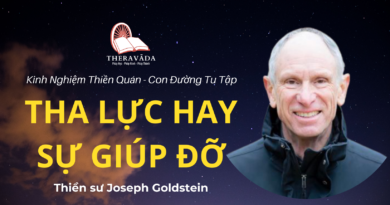HANDBOOK FOR MANKIND – 9. EMANCIPATION FROM THE WORLD
HANDBOOK FOR MANKIND – 9. EMANCIPATION FROM THE WORLD
Vipassana meditation is mental training aimed at raising the mind to such a level that it is no longer subject to suffering. The mind breaks free from suffering by virtue of the clear knowledge that nothing is worth grasping at or clinging to. This knowledge deprives worldly things of their ability to lead the mind into further thoughtless liking or disliking. Having this knowledge, the mind transcends the worldly condition and attains the level known as the Supramundane Plane (Lokuttara-bhumi).
In order to comprehend clearly the supramundane plane, we have to know first about its opposite, the mundane plane (Lokiyabhumi). The mundane plane comprises those levels at which the things of the world have control over the mind. Very briefly, three levels are recognized in the mundane plane, namely: the sensual level (Kamavacara-bhumi), or the level of a mind still content with pleasures of every kind; the level of forms (Rupavacara-bhumi), the condition of a mind uninterested in sensual objects, but finding satisfaction in the various stages of concentration on forms as objects; and lastly the formless level (Arupavacara-bhumi), the yet higher level of a mind finding satisfaction in the bliss and peace of concentration on objects other than forms. These three levels in the worldly plane are the mental levels of beings in general. Regardless of whether we presume to call them human beings, celestial beings, gods, beasts, or denizens of hell, they are all included within the three worldly levels. The mind of a worldling can at any particular time exist in any one of these three. It is not impossible. It is quite normal. As a rule, though, it will tend to fall back naturally to the unconcentrated sensual level; the human mind normally falls under the influence of the delightful in colors and shapes, sounds, odors, tastes and tactile objects. Only on certain occasions is it able to escape from the influence of these seductive things and experience the tranquillity and bliss which comes from practicing concentration on forms or other objects. It all depends on concentration. At certain times, then, a person’s mind may be located in any of these levels of concentration. In India at the time of the Buddha this must have been fairly common, because people who had gone in search of the tranquillity and bliss associated with the various levels of concentration were to be found living in forests all over the country. At the present time such people are few, but it is nevertheless possible for the ordinary man to attain these levels. If someone in this world is in the process of experiencing the bliss of full concentration on a form, then for him “the world” consists of just that form, because he is aware of nothing else. At that time and for that person, “the world” is equivalent to just that one form, and it remains so until such time as his mental condition changes.
Even though a person dwelling in any of these three levels may have gained such bliss and calm tranquillity that he has come to resemble a rock, a lump of earth, or a log of wood, yet grasping and clinging to selfhood are still present. Also present are various kinds of desire, albeit of the finest and most tenuous sort, such as dissatisfaction with the state in which he finds himself, which prompts him to go in search of a new state. That desire for change constitutes karma, so such a person has not yet transcended the worldly state. He is not yet in the supramundane plane. A mind dwelling in the supramundane plane has transcended the world. It views the worldly state as devoid of essence, self, or substance, and will have nothing of it. Dwellers in this supramundane plane can be further classified into grades. There are four levels of Path and Fruit, namely the levels of the Stream – enterer (Sotapanna), the Once – returner(Skidagami), the Never – returner (Anagami), and the completely Perfected individual or Arahant. The condition of these four kinds of noble individuals or Aryians is the supramundane condition. “Supramundane” means “above the world,” and refers to the mind, not the body. The body can be anywhere at all as long as living conditions are adequate. “Supramundane” simply describes a mind dwelling above the world. As for the nether worlds such as hell, purgatory, or the places of suffering, torment and bondage, these are out of the question for the Aryians.
The criteria for recognizing these four levels in the supramundane plane are the various mental impurities which are in the course of being eliminated. The Buddha divided the impurities in this group into ten kinds. He called them the Fetters (Samyojana). These ten fetters bind man and all beings to the world, keeping people in the mundane plane. If a person starts to cut through these fetters and break loose, his mind gradually and progressively becomes freed from the worldly condition; and when he manages to cut through them completely, his mind becomes completely free, transcends the world for good and comes to dwell permanently in the supramundane plane.
Of these ten kinds of subtle mental impurities that bind us, the first is the Self belief (Sakkaya-ditthi), the view that the body and mind is “my self.” It is a misunderstanding or misconception based on clinging to the idea “I am.” Because the average person is not aware of the true nature of the body and the mind, he unthinkingly regards these two as his “self.” He assumes that body and mind is his “self,” his “I.” This instinctive idea that there is an “I” and a “mine” is so firmly ingrained that normally nobody ever doubts their existence. True, the self instinct is what makes life possible, being the basis of self preservation, the search for food and propagation of the species, but in this case, what we are calling the self belief is to be taken only in its most basic sense as the root cause of selfishness. This is considered to be the first of the fetters, to be done away with before anything else.
The second fetter is Doubt (Vicikiccha), the cause of wavering and uncertainty. Most importantly it is doubt concerning the practice leading to liberation from suffering-doubt due to inadequate knowledge, doubt as to what this subject is really all about, doubt as to whether this practice for breaking free from suffering is really the right thing for one, whether one is really capable of carrying it through, whether it is really better than other things, whether or not it really does any good, whether the Buddha really did attain enlightenment, whether he really did achieve liberation from suffering, whether the Buddha’s teaching and the practical method based on his teaching really do lead to liberation from suffering, whether it is really possible for a bhikkhu in the Sangha to attain liberation from suffering.
The root cause of hesitancy is ignorance. A fish that has always lived in the water, if told about life on dry land, would be sure to believe none of it, or at most only half of it. We, immersed as we are in sensuality, are as habituated to sensuality as is the fish to water, so that when someone speaks of transcending sensuality, transcending the world, we can’t under stand. And that which we can understand to some extent we are hesitant about. It is natural for us to think on this lower level; to think on the high level produces a new picture. The conflict between the high level thinking and the low level thinking is what constitutes wavering. If mental energy is insufficient, the low level thinking will triumph. Doubt and wavering with regard to goodness is something chronically present in everyone right from birth. In a person who has been brought up wrongly, it may be a very common complaint. We have to introspect and note the bad consequences of this wavering, which is present to such an extent in our work and our everyday living that we become skeptical about goodness, truth and liberation from suffering.
The third fetter is Superstition (Silabbatapraramasa) or attachment to rules and rituals based on a misunderstanding
of their real purpose. Essentially it is a misguided attachment to certain things one does. Usually it has to do with doctrines and ceremonies. An example of this is belief in magic and magical practices, which is blatantly just superstition and occurs even among Buddhists. Practice based on the belief that it will produce magical abilities, psychic powers and protective forces is founded on false hopes and is irrational. Another example is the undertaking of moral precepts (Five Precepts, etc.) or virtuous conduct. The real purpose of this is to eliminate mental defilements; but if we believe that it will give rise to miraculous powers which we shall then be able to use to eradicate the defilements, we are in fact grasping and clinging, and so defeating our original purpose. The practice is quite correct in itself, but if we misunderstand it and cling to it irrationally, regarding it as something magical or sacred, then it becomes pure superstition. Even taking upon oneself the moral precepts, if done in the belief that it will lead to rebirth as a celestial being, is without a doubt an example of attachment to rules and rituals and goes contrary to Buddhist aims. Such beliefs contaminate otherwise virtuous conduct. The objective of the Buddhist discipline is the elimination of the cruder defilements of body and speech as a foundation for the progressive development of concentration and insight. The objective is not rebirth in heaven. To have such false motives is to soil and contaminate one’s own morals with grasping and clinging, with false ideas. Charity, or adherence to moral precepts, or meditation practice, if carried out with a mistaken idea of their true objective. inevitably will stray from the Buddhist path. Do understand that even Buddhist practice associated with misunderstanding because craving has come in and taken over, bringing the expectation of mystical powers, becomes superstition instead. This applies to even the very small and trivial things that most of us like to indulge in, such as ritual chanting, merit making and the like. The ceremony of placing rice and trays of sweets before the Buddha’s image, if performed in the belief that it is an offering to the Buddha’s “spirit” and that he will be able to partake of it, is 100 percent certain to produce effects precisely the opposite of what the devotee is hoping for. Behavior that defeats its own true purpose is generally quite common in Buddhist circles. It is foolish and irrational and results in practices originally worthwhile and attractive becoming contaminated with the stupidity and ignorance of the people performing them. This is what is meant by superstition. As we can see, this defilement has its origins in delusion and misunderstanding. Most of us have our own ingrown beliefs in mystical powers as a result of having been misinformed and led astray by others. We need not go into any more detail here; but though it may be rather disturbing, everyone ought to do some critical self-examination along these lines.
When these first three defilements, namely self belief, doubt and superstition, have been completely given up, one is said to have attained the lowest level in the supramundane plane, that is, to have become a Stream enterer. To give up completely these three defilements is not difficult at all, because they are just primitive qualities possessed by primitive, under-developed people. In anyone who has studied well and made progress, these three elements should not be present; and if they are, then that person’s mind should be considered still primitive. Anyone ought to be able to give up these three defilements and become an Aryian. If he can’t he is still a foolish and deluded person, or, to use the best term, a worldling (Puthujjana), someone with a thick blindfold covering the eye of insight . When any individual has managed to give up these defilements, his mind is freed from bondage to the world. These three are ignorance and delusion obscuring the truth and are fetters binding the mind to the world. Giving them up is like rendering ineffective three kinds of bondage or three blind folds, then slipping free and rising above and beyond the world, into the first supramundane level. This is what it is to become an Aryian of the first degree, to attain the first level in the supramundane plane. Such an individual is called a “Stream – enterer,” one who has attained for the first time the Stream that flows on to Nirvana. In other words an individual at this stage is certain to attain Nirvana at some time in the future. What he has attained is only the Stream of Nirvana, not Nirvana itself. This Stream is a course that flows right on to Nirvana, inclining towards Nirvana just as the water-course of a river slopes down towards the sea. Though it may still take some time, a mind which has once entered the Stream is certain to achieve Nirvana eventually. Attaining the second level in the supramundane plane implies giving up the three fetters just mentioned, and further, being able to attenuate certain types of craving, aversion and delusion to such a degree that the mind becomes elevated and only very feebly attached to sensuality. It is traditionally held that an individual who achieves this level will return to this world at most only once more, hence he is known as a “Once – returner.” A Once – returner is closer to Nirvana than a Stream – enterer, there remaining in him no more than a trace of worldliness. Should he return to the sensual human world, he will do so not more than once, because craving, aversion and delusion, though not completely eliminated, have become exceedingly attenuated.
The third stage is that of the Never – returner. This grade of Aryian, besides having succeeded in giving up the defilements to the extent necessary for becoming a Once – returner, has also managed to give up the fourth and fifth fetters. The Fourth fetter is sensual desire and the fifth is ill will. Neither the Stream – enterer nor the Once – returner has completely given up sensual desire. In both of them there is still a remnant of satisfaction in alluring and desirable objects. Even though they have managed to give up self belief, doubt and superstition, they are still unable to relinquish completely their attachment to sensuality of which some traces remain. But an Aryian at the third stage, a Never – returner, has succeeded in giving it up completely, so that not a trace remains. The defilement called ill will, which includes all feelings of anger or resentment, has been washed out to a large extent by the Once – returner so that there remains only a trace of ill humor to obstruct his mind; but the Never – returner has got rid of it altogether. Thus the Never – returner has thrown off both sensual desire and ill will.
This sensual desire or attachment to and satisfaction in sensuality was explained adequately in the section on sensual attachment. It is a chronic defilement, firmly fixed in the mind as if it were a very part of it, of the same substance. For the ordinary man, it is hard to understand and hard to eradicate. Anything at all can serve as an object for desire: colors and shapes, sounds, odors, tastes and tactile objects of any sort, kind and description. These are sensual objects (Kama), and the state of mental attachment which takes the form of satisfaction in these desirable objects is sensual desire (Kama – raga). What we call ill will is the reaction of a mind that feels dissatisfaction. If there is satisfaction, there is sensual desire; if dissatisfaction, ill will. Most people’s minds are subject to these two states. There may arise ill will towards even inanimate objects, and what is more, one can even be dissatisfied with the things one has produced oneself, the things that arise in one’s own mind. Where there is actual hatred and anger towards an object, ill will has become too fierce. An Aryian at a stage below the Non – returnee has given it up to a degree appropriate to his station. The ill will that remains for the third grade of Aryian to relinquish is just a mental reaction so subtle that possibly no outward evidence of it appears. It is an inner perturbation not revealed by any facial expression, yet present inwardly as dissatisfaction, as irritation or annoyance at some person or thing that does not conform to expectation. Imagine a person completely devoid of every form of ill will: consider what a very exceptional individual he would be, and how worthy of respect. The five defilements we have just been discussing were grouped together by the Buddha as the first to be given up. Self belief, doubt, superstition, sensual desire and ill will have all been given up by an Aryian at the third level. Because there remains no sensual desire, this grade of Aryian never again returns to the sensual state of existence. This is why he gets the name “Never – returner,” one who will never come back. For him there is only movement forward and upward to Arahantship and Nirvana, in a state having nothing to do with sensuality, a supreme, divine condition. As for the five remaining defilements, these only the Arahant, the fourth grade of Aryian, succeeds in relinquishing completely.
The next defilement, the sixth of the fetters, is desire for the bliss associated with the various stages of concentration on forms (rupa – raga). The first three grades of Aryian are still not capable of giving up attachment to the bliss and tranquillity obtainable by concentrating deeply on forms, but they will succeed in doing so when they move up to the last stage, that of the Arahant. The fully concentrated state has a captivating flavor, which can be described as a foretaste of Nirvana. Though it differs from real Nirvana, it has more or less the same flavor. While one is fully concentrated, the defilements are dormant; but they have not evaporated away entirely, and will reappear as soon as concentration is lost. As long as they are dormant, however, the mind is empty, clear, free, and knows the flavor of real Nirvana. Consequently this state can also become a cause of attachment.
The seventh subtle defilement is desire for the bliss associated with full concentration on objects other than forms (arupa – raga). It resembles the sixth fetter, but is one degree more subtle and attenuated. Concentration on an object such as space or emptiness yields a tranquillity and quiescence more profound than concentration on a form, with the result that one becomes attached to that state. No Arahant could ever become fascinated by any state of pleasant feeling whatsoever, regardless of where it originated, because an Arahant is automatically aware of the impermanence, unsatisfactoriness and nonselfhood of every state of feeling. Other hermits and mystics practicing concentration in the forest do not perceive the hidden danger in these blissful states and so become fascinated by and attached to the flavor of them just as immature people become attached to the flavor of sensual objects. For this reason the Buddha used the same word “desire” for both cases. If you think this subject over and really come to understand it, you will be full of admiration and respect for these individuals called Aryians. The eighth fetter binding a man to the world is awareness of superiority or inferiority (mana). It is the delusion of having this or that status relative to another. It consists in the thought: “I am not as good as he is. I am just as good as he is. I am better or higher than he is.” Thinking “I am not as good as…,” one feels inferior; thinking “I am better than…,” one feels puffed up; and thinking “I am just as good as…,” one thinks along competitive lines or in terms of getting ahead of the other fellow. It is not pride or conceit. Not to think automatically of oneself as better or worse than the other fellow in this fashion is bound to be very difficult. The placing of this defilement as number eight is probably meant to indicate that it is hard to give up and so belongs near the end of the list. Only the highest grade of Aryian can relinquish it. The likes of us naturally can’t give it up. This idea that one is better than, or on a par with, or not as good as the other fellow, comes from a certain kind of attachment. As long as the mind is still involved in good and bad, the awareness of inferiority, superiority, or equality with respect to others remains to disturb it; but when it has completely transcended good and bad, such ideas cannot exist. As long as such ideas do remain, real bliss and tranquillity are lacking.
The ninth fetter is Agitation (Uddhacca), that is, mental unrest, distraction, lack of peace and quiet. This is the feeling of agitation that arises when something interesting comes by. We all have certain chronic wishes, particularly a desire to get, to be, not to get, or not to be, one thing or another. When something comes by, via the eye, ear, nose, tongue, or body, which fits in with one of our tendencies, there is likely to come about the mental reaction, pro or con, which we call interest. If we see something new and strange, wavering and curiosity are bound to arise, because there are still things that we want and things that we fear and mistrust. So the mind cannot resist, it has to be interested in the various things that come by- at least that is how it is with an ordinary person. If the object in question happens to coincide with a desire of his, he finds it hard to resist. He is likely to become interested to the point of becoming involved, pleased to the point of forgetting himself. If it is an undesirable object, the mind becomes depressed so that his gratification comes to an end. This is the nature of Agitation.
The first three grades of Aryian still have curiosity and inquisitiveness about things, but the Arahant has none at all. His mind has abolished all desire for anything whatsoever: it has abolished fear and hatred, worry and anxiety, mistrust and doubt, and all desire to know about and see things. His mind is free. Nothing can provoke or lure him, and arouse inquisitiveness or curiosity, simply because he has abolished partiality. It should be realized that the existence or arising of agitation in any situation is a consequence of some form of desire, even including the desire for knowledge. When desire has been done away with through realizing the impermanence, worthlessness and nonselfhood of all things, nothing is any longer seen as worth getting or being, and so there is no curiosity about anything. If a bolt of lightning were to strike right beside an Arahant, he would not be interested, because he has no fear of death, or craving for continued existence, or anything of that sort. Even if something dangerous came along, or if something brand new were discovered in the world, he would know no inquisitiveness or curiosity, because such things have no significance for him. He has no wish to know about anything from the point of view of what it may have to offer him. Because there is nothing that he longs for, he has no curiosity of any kind, and his mind has a purity, a tranquillity such as we ordinary folk have never attained.
The tenth and last defilement is Ignorance. This covers every kind of defilement not yet mentioned. The word “ignorance” refers to a condition of lack of knowledge, and in this case “knowledge” means real knowledge, correct knowledge. Naturally no creature can exist without having some knowledge, but if that knowledge is false, it has the same value as no knowledge. Most people suffer from chronic ignorance or false knowledge; most of us are benighted. The most important questions for human beings are those that ask: “What is suffering, really?,” “What is the real cause of the arising of suffering?,” “What is real freedom from suffering?” and “What is the real way to attain freedom from suffering?” If some individual has real knowledge, if he is free of ignorance, he is reckoned as enlightened. The totality of human knowledge is of untold extent, but the Buddha classed most of it as not essential. The Buddha’s enlightenment encompassed only what need be known. The Buddha knew all that need be known. The word “omniscient” or “all – knowing” means knowing just as much as need be known: it does not include anything non-essential.
Ignorance causes people to misidentify suffering as pleasure, to such an extent that they just swim around in circles in a sea of suffering. It also causes them to misidentify the cause of suffering, so that they go blaming the wrong things, spirits, celestial beings, or anything at all as the cause of their pain and misfortune, instead of rectifying the situation by the right means. The making of vows to these spirits and celestial beings is a manifestation of the lowest level of ignorance regarding the complete elimination of suffering by means of eliminating the craving which is its direct cause. The mistaken assumption that the bliss and tranquillity or unawareness brought about by deep concentration is the complete extinction of suffering was common in the Buddha’s time, and is still promoted in the present day. Certain schools of thought have even come to regard sensuality as an instrument for extinguishing suffering, so that sects with shameful, obscene practices have arisen right in the temples. They firmly believe that sensuality is something quite essential, a kind of vital nourishment. Not content with just the four necessities of life, namely food, clothing, shelter and medicine, they add an extra one, sensuality, making five necessities. A person ignorant about the Path that leads to the extinction of suffering is liable to act foolishly and be motivated by his own desires, for instance naively relying on physical things, or on spirits and celestial beings, just as if he had no religion at all. Such a person, though he may be a Buddhist by birth, is able to go to such foolish lengths simply because the power of ignorance prevents his being content with extinguishing suffering by way of the Noble Eightfold Path. Instead he goes about extinguishing suffering by lighting incense and candles, and making pledges to supposedly supernatural things.
Every normal person wishes to gain knowledge; but if the “knowledge” he gains is false, then the more he “knows,”‘ the more deluded he becomes. Thus more kinds of knowledge can blind the eyes. We have to be careful with this word “enlightenment.” The “Light” may be the glare of ignorance, which blinds and deludes the eye and gives rise to overconfidence. Blinded by the glare of ignorance, we are unable to think straight and so are in no position to defeat suffering. We waste our time with trivialities, nonessential things unworthy of our respect. We become infatuated with sensuality, taking it to be something excellent and essential for human beings, something which every man ought to get his share of before he dies, and making the excuse that we are doing it for the sake of some quite different ideal. The hope for rebirth in heaven is founded on sensuality. Attachment to anything whatsoever, particularly sensuality comes about because ignorance has enveloped the mind cutting off all means of escape. At several places in the Texts, ignorance is compared to a thick shell covering the whole world and preventing people from seeing the real light.
The Buddha placed ignorance last in the list of the ten fetters. When a person becomes an Arahant, the highest grade of Aryian, he completely eliminates the five remaining fetters or defilements. He eliminates desire for forms, desire for objects other than forms, status consciousness, agitation and ignorance. The four kinds of Aryian, Stream – enterer, Once – returner, Never – returner and Arahant, dwell in the Supra mundane plane. The Supramundane can be recognized as having nine aspects. The condition of the Stream – enterer while he is in the process of cutting out the defilements is called the Path of Stream entry, and that when he has succeeded in cutting them out is called the Fruit of Stream entry. Likewise there are the following pairs: Path and Fruit of Once returning, Path and Fruit of Never returning and Path and Fruit of Arahantship, in all four pairs. These together with Nirvana make up the nine aspects of the Supramundane. For an individual in the supramundane plane, suffering is diminished in accordance with his status until ultimately he is completely free of it. When a person once succeeds in attaining unobscured and perfect insight into the true nature of things so that he is able to stop desiring anything whatsoever, he has attained the supramundane plane, his mind has transcended the worldly condition. And when he has completely and utterly relinquished all the mental defilements, his mind is rendered permanently free of all those worldly things which formerly it liked and disliked.
Nirvana is a condition not in any way comparable to any other. It is unlike any worldly condition. In fact, it is the very negation of the worldly condition. Given all the characteristics of the worldly condition, of phenomenal existence, the result of completely canceling out all those characteristics is Nirvana. That is to say, Nirvana is that which is in every respect precisely the opposite of the worldly condition. Nirvana neither creates nor is created, being the cessation of all creating. Speaking in terms of benefits, Nirvana is complete freedom from hellfire, scourging, torture, bondage, subjection and thralldom, because the attainment of Nirvana presupposes the complete elimination of the defilements, which are the cause of all unsatisfactory mental states. Nirvana lies beyond the limitations of space and time. It is unique, unlike anything in the world. Rather it is the extinction of the worldly condition. Speaking metaphorically, the Buddha called it the realm where all conditional things cease to be (Sankhara – samatho). Hence it is the condition of freedom, of freedom from fetters. It is the end of torment and buffeting, stabbing and chafing, from any source whatsoever. This is the nature of the Supramundane, the ultimate. It is the Buddhist goal and destination. It is the final fruit of Buddhist practice. In the foregoing pages we have explained systematically the principles of Buddhism. We have presented it as an organized practical system designed to bring knowledge of the true nature of things. In reality things are impermanent, unsatisfactory and not selves; but all creatures are attracted by things and become attached to them simply through misunderstanding. The Buddhist practice, based on Morality (Sila), Concentration (Samadhi), and Insight (Panna), is a tool to be used for completely cutting out grasping and clinging. The objects of our clinging are the five aggregates: body, feeling, perception, active thinking and consciousness. When we have come to know the true nature of the five aggregates, we understand all things so well that desire gives way to disenchantment, and we no longer cling to any of them.
What we have to do is lead the kind of life described as Right Living (Samma Vihareyyum), and be full day and night with the joy that arises out of conduct that is consistently good, beautiful and right. This limits aimless wandering of the thoughts and makes it possible to concentrate and to have clear insight at all times. Then if conditions are right, the result is disenchantment, struggle to break loose, slipping free, or even complete Nirvana. If we wish to hurry and gain quick results, then there is the line of practice called Vipassana, which begins with moral purity and mental purity and carries right through to perfect and unobscured intuitive insight. By this means we can completely cut through the fetters that bind us fast to this world, and attain the final Fruit of the Path. This is a brief account of the whole of Buddha-Dhamma from beginning to end, including both theoretical and practical principles, and covering the entire subject right from the first steps to the final Fruit. The whole story ends with Nirvana. As the Buddha said: “All Buddhas recognize Nirvana as the highest good.” So it behooves us to practice in order to realize and attain that which should be realized and attained. Doing this, we shall deserve to be called Buddhists; we shall gain insight and penetrate to the real essence of BuddhaDhamma. If we don’t practice Buddha-Dhamma, we shall only know about it and shall lack any true insight. It rests with each of us to practice introspection, observe and understand his own imperfections, and then try to root them out completely. Even if one is only half successful, some clear understanding will result. As the defilements are progressively eliminated, their place is taken by purity, insight and peace. So I advise and beseech you to approach the subject in this fashion. You may then succeed in penetrating to the real Buddha- Dhamma. Don’t waste the advantages of having been born a human being and having encountered the Buddha’s teaching. Don’t miss this chance to be a perfect human being.









